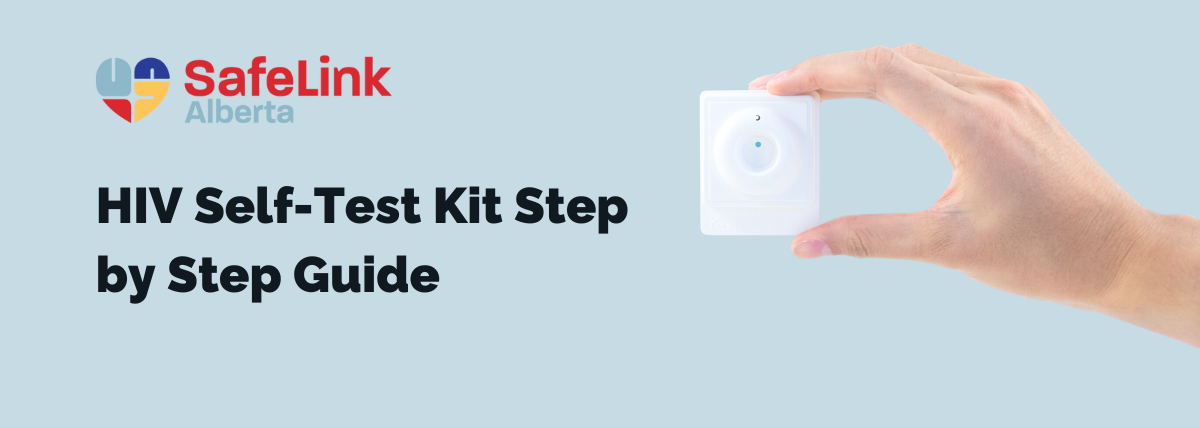HIV self-testing was first made available in Canada in November 2020 and offers individuals a safe, convenient, and private way to determine their HIV status. This blog post will give you the basic steps to prepare a self-test kit, where to get them, and the benefits of testing.
How the Test Works:
This screening test relies on detecting HIV antibodies in a blood sample obtained through a finger prick. The self-test detects HIV antibodies, with results available in less than five minutes. However, the window period, the time between potential exposure and when antibodies become detectable, can vary. If a reactive (positive) result occurs, you should confirm the result with a laboratory test.
What’s in the Kit:
A self-test kit includes a testing device (like a covid test), three bottles, a bandage, and a lancet.
How to Use the Test:
- Wash a surface (a hard table works best) with warm water and soap or an alcohol swap.
- Unpack all the components of the test onto the clean surface.
- Optional: Open the band aid now, as it can be difficult to open after your finger has been poked.
- Warm your hands under hot water or by rubbing them – this makes it easier to collect the blood sample.
- Choose which finger you would like to use. Middle and pointer fingers are most common, and you want to poke the side, not finger pad with the lancet.
- Clean hands with warm soapy water or alcohol swab. Make sure your fingers are dry, as a blood drop won’t form on moist skin.
- Open bottle 1 and twist open the lancet. The lancet will only activate once.
- Place the lancet against the side of the finger and press firmly to activate. This will puncture the skin.
- Wipe away the first drop of blood with a clean, dry tissue.
- Massage the side of the finger to form a new drop of blood. Ensure the blood drops into the bottle without touching the sides of the bottle, as this might produce an invalid test. Do not scrape the blood drop into the bottle on the sides.
- Bandage your finger.
- Put on the lid and shake the bottle by flipping it upside down 10 times. Pour into the testing device and allow liquid to be absorbed.
- Shake the contents of bottle 2 the same way and pour into the testing device allowing liquid to be absorbed. Repeat with bottle 3.
- Results will show after the contents of bottle 3 are absorbed. A positive test will have two dots. A negative test will have a dot at the top. An invalid test might have no dots or a single dot on the bottom.
Positive Test:
Negative Test:
Invalid Tests:




Accuracy of HIV Self-Test:
The HIV Self-Test boasts high accuracy, with a sensitivity of 99.6% and a specificity of 99.3%. While false positives and negatives are rare, confirmatory testing is essential to ensure accurate results.
Results:
A reactive result suggests a positive status, while a non-reactive result indicates a negative status. An invalid test may occur due to user error or kit malfunction. Individuals with non-reactive results should consider retesting periodically, especially if at ongoing risk.
Where to Get Them:
You can get up to 5 free HIV self-test kits at SafeLink Alberta locations. A team member can also walk you through the process, stay with you during the test, and provide resources in the event of a positive result.
SafeLink Alberta Calgary Location:
1944 10 Ave SW
Calgary AB, T3C 0J8
Phone: 403. 508.2500
SafeLink Alberta Medicine Hat Location:
411 N Railway S.
Medicine Hat AB, T1A 2Z3
Phone: 403. 527.5882
Hours of Operation
Monday – Friday
9 a.m. – 12 p.m. by appointment
1 – 4 p.m. drop-ins welcome
Benefits of Self-Testing:
HIV self-test kits provide an accessible and low-barrier solution for individuals to check their HIV status. Many people, especially those residing in rural areas or facing stigma and institutional violence, may find it challenging or uncomfortable to access traditional health institutions. With self-testing, individuals can take control of their health, allowing them to learn about their HIV status at their own pace. This approach empowers individuals to make informed decisions about their next steps without feeling pressured by institutional processes.
Video Demonstration
Watch Kayla from SafeLink Alberta Medicine Hat demonstrate the HIV self-test kit process, tips, and best practices.
References:
https://www.catie.ca/hiv-self-testing-0
https://myhealth.alberta.ca/Alberta/Pages/HIV-Self-Test-What-you-need-to-know.aspx

